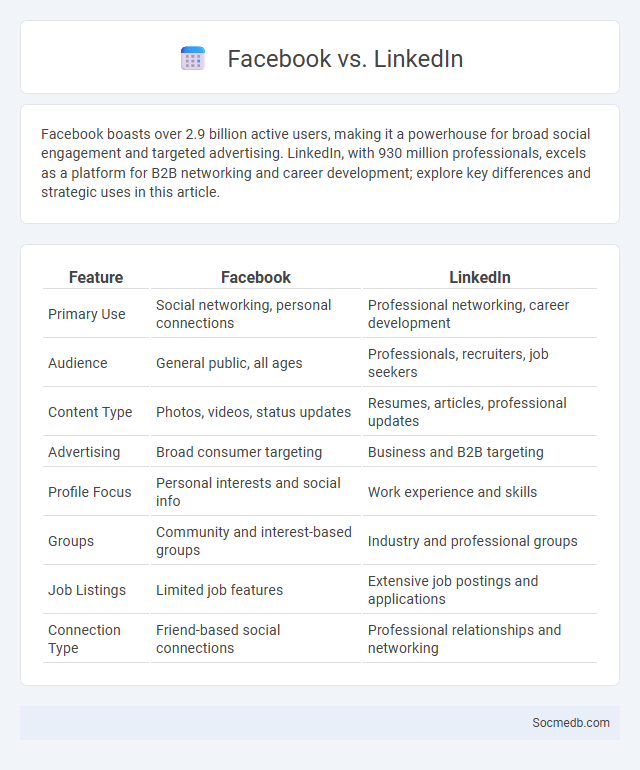
Photo illustration: Facebook vs LinkedIn
Facebook boasts over 2.9 billion active users, making it a powerhouse for broad social engagement and targeted advertising. LinkedIn, with 930 million professionals, excels as a platform for B2B networking and career development; explore key differences and strategic uses in this article.
Table of Comparison
| Feature | ||
|---|---|---|
| Primary Use | Social networking, personal connections | Professional networking, career development |
| Audience | General public, all ages | Professionals, recruiters, job seekers |
| Content Type | Photos, videos, status updates | Resumes, articles, professional updates |
| Advertising | Broad consumer targeting | Business and B2B targeting |
| Profile Focus | Personal interests and social info | Work experience and skills |
| Groups | Community and interest-based groups | Industry and professional groups |
| Job Listings | Limited job features | Extensive job postings and applications |
| Connection Type | Friend-based social connections | Professional relationships and networking |
Facebook vs LinkedIn vs Trending: Overview
Facebook remains the largest social media platform with over 2.9 billion monthly active users, emphasizing personal connections and entertainment. LinkedIn, boasting more than 900 million members, specializes in professional networking, job searching, and B2B marketing. Trending platforms such as TikTok and Instagram focus on short-form video content and influencer marketing, shaping new digital engagement strategies.
Core Purpose: Social Networking vs Professional Networking
Social media platforms serve distinct core purposes, with social networking focusing on building personal relationships and sharing everyday experiences, while professional networking centers on career development, industry connections, and job opportunities. Your choice of platform should align with your goals, whether fostering friendships on Facebook or advancing your career via LinkedIn. Understanding these differences maximizes the value and effectiveness of your online interactions.
Audience Demographics and User Base
Social media platforms attract diverse audience demographics, with Instagram leading among users aged 18-34 and Facebook dominating the 35-54 age group. TikTok sees the highest engagement from Gen Z, making it a vital channel for brands targeting younger consumers. Understanding these user base distinctions enables marketers to tailor content and optimize engagement strategies effectively.
Content Types: Personal, Professional, and Viral Trends
Social media content can be categorized into personal, professional, and viral trends, each serving distinct purposes and audiences. Personal content typically includes everyday moments and opinions, fostering genuine connections with friends and family. Professional content, such as industry insights and portfolio showcases, helps build your brand credibility, while viral trends leverage popular hashtags and challenges to boost visibility rapidly.
Engagement and Interaction Differences
Engagement on social media varies significantly across platforms, with Instagram emphasizing visual interactions like likes and comments, while Twitter prioritizes real-time conversations through retweets and replies. Understanding these interaction differences helps you tailor content strategies to boost user participation effectively. Measuring metrics such as click-through rates, shares, and time spent on posts provides insights into the depth and quality of your audience engagement.
Algorithms and Content Discovery
Social media platforms utilize complex algorithms to personalize content discovery, enhancing user engagement by analyzing behavior patterns, interests, and interactions. These algorithms prioritize relevant posts, advertisements, and recommendations, increasing the visibility of content likely to resonate with individual users. Continuous advancements in machine learning enable platforms like Facebook, Instagram, and TikTok to refine content curation, resulting in more precise and dynamic user experiences.
Advertising Opportunities and ROI
Social media platforms offer targeted advertising opportunities that leverage user data and behavior to optimize campaign reach and engagement. Advertisers can achieve high ROI by utilizing advanced analytics, audience segmentation, and retargeting features available on platforms like Facebook, Instagram, and LinkedIn. Efficient budget allocation and continuous performance monitoring further enhance ad effectiveness, driving measurable business growth.
Career Growth vs Social Influence
Social media platforms serve as powerful tools for career growth by enabling professionals to showcase skills, network with industry leaders, and access job opportunities directly. While social influence often centers on follower counts and content virality, true career advancement on social media depends on strategic engagement, thought leadership, and skill demonstration. Platforms like LinkedIn emphasize career development, whereas Instagram and TikTok primarily foster social influence but can also be leveraged for professional branding.
Privacy, Security, and Data Usage
Social media platforms collect vast amounts of user data, raising significant privacy concerns regarding how personal information is stored, shared, and potentially exploited. Robust security measures such as end-to-end encryption and multi-factor authentication are essential to protect user accounts from unauthorized access and cyberattacks. Transparent data usage policies and compliance with regulations like GDPR and CCPA help ensure users maintain control over their digital footprints and consent to data processing practices.
Choosing the Right Platform for Your Goals
Selecting the ideal social media platform depends on your specific goals and target audience demographics. Platforms like Instagram and TikTok excel in visual storytelling and reaching younger users, while LinkedIn is optimal for professional networking and B2B marketing. Tailoring your content strategy to the strengths of each platform ensures maximum engagement and effective achievement of your marketing objectives.
 socmedb.com
socmedb.com